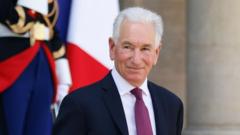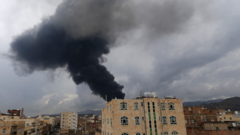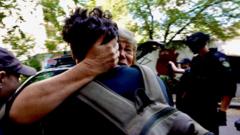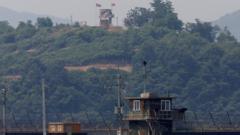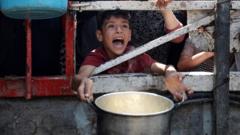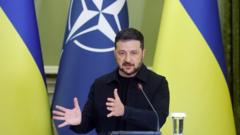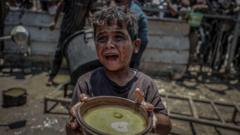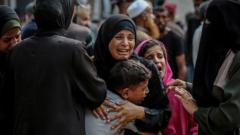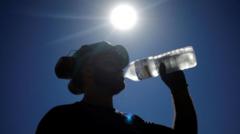#### The situation in Gaza City has deteriorated rapidly as Israeli military operations ramp up in response to Hamas, leading to grave humanitarian concerns for the local population.
### Escalating Conflict: Israel Intensifies Bombardment of Gaza City
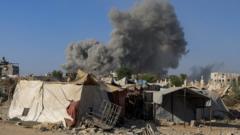
### Escalating Conflict: Israel Intensifies Bombardment of Gaza City
#### A humanitarian crisis looms as Israel escalates attacks in Gaza City, affecting nearly a million residents amidst ongoing hostilities.
The violence in Gaza City has reached alarming levels, as Israeli forces continue heavy bombardment, targeting urban areas in preparation for an extensive ground offensive. With nearly one million Palestinians caught in the crossfire, the situation grows increasingly desperate. Eyewitnesses report relentless explosions shaking northern and eastern neighborhoods, as Israeli troops have intensified operations, which include demolishing buildings in the Jabalia refugee camp.
The latest figures from Hamas-controlled health authorities indicate that the relentless assaults have resulted in the deaths of over 62,000 people and injured approximately 158,000 since the conflict escalated following a deadly Hamas attack on southern Israel on October 7. That incident claimed the lives of around 1,200 Israelis and led to many being taken hostage.
Israeli Prime Minister Benjamin Netanyahu remains resolute in his goal to dismantle Hamas, disregarding mounting international outrage regarding the extensive military campaign that is poised to expand. In an effort to reinforce its military capabilities, Israel has summoned around 60,000 reservists.
Although a full-scale ground invasion has yet to commence, aerial bombardments have inflicted significant damage overnight in areas like Zeitoun and Shejayia, while tank fire targeted adjacent neighborhoods. The Israel Defense Forces (IDF) assert that their military actions aim to prevent Hamas from regrouping and to maintain pressure on the group.
In a separate development, the World Health Organization (WHO) reported the release of one of its staff members detained in Gaza since July 21, but details regarding the incident remain sparse.
As pressure mounts on Netanyahu from within Israel, particularly from families of the hostages, there is an ongoing dilemma over whether to pursue negotiations for a ceasefire that might secure the release of hostages. Indirect discussions with mediators from Qatar and Egypt were met with resistance from Israeli officials, who now insist on a comprehensive agreement rather than a partial deal.
With the humanitarian situation worsening—over 90% of homes reported damaged or destroyed—UN agencies have raised alarms about the potential catastrophic humanitarian impact of the imminent offensive. They highlight the breakdown of critical infrastructure, including a healthcare system that is barely functional, alongside widespread food scarcity confirmed for the first time in recent assessments.
As the conflict shows no signs of abating, the displaced populations within Gaza City continue to face dire conditions, with international observers urgently calling for solutions to address the mounting humanitarian crisis. The implications of this ongoing conflict resonate far beyond regional borders, drawing attention from global citizens concerned about the future of peace and stability.
The latest figures from Hamas-controlled health authorities indicate that the relentless assaults have resulted in the deaths of over 62,000 people and injured approximately 158,000 since the conflict escalated following a deadly Hamas attack on southern Israel on October 7. That incident claimed the lives of around 1,200 Israelis and led to many being taken hostage.
Israeli Prime Minister Benjamin Netanyahu remains resolute in his goal to dismantle Hamas, disregarding mounting international outrage regarding the extensive military campaign that is poised to expand. In an effort to reinforce its military capabilities, Israel has summoned around 60,000 reservists.
Although a full-scale ground invasion has yet to commence, aerial bombardments have inflicted significant damage overnight in areas like Zeitoun and Shejayia, while tank fire targeted adjacent neighborhoods. The Israel Defense Forces (IDF) assert that their military actions aim to prevent Hamas from regrouping and to maintain pressure on the group.
In a separate development, the World Health Organization (WHO) reported the release of one of its staff members detained in Gaza since July 21, but details regarding the incident remain sparse.
As pressure mounts on Netanyahu from within Israel, particularly from families of the hostages, there is an ongoing dilemma over whether to pursue negotiations for a ceasefire that might secure the release of hostages. Indirect discussions with mediators from Qatar and Egypt were met with resistance from Israeli officials, who now insist on a comprehensive agreement rather than a partial deal.
With the humanitarian situation worsening—over 90% of homes reported damaged or destroyed—UN agencies have raised alarms about the potential catastrophic humanitarian impact of the imminent offensive. They highlight the breakdown of critical infrastructure, including a healthcare system that is barely functional, alongside widespread food scarcity confirmed for the first time in recent assessments.
As the conflict shows no signs of abating, the displaced populations within Gaza City continue to face dire conditions, with international observers urgently calling for solutions to address the mounting humanitarian crisis. The implications of this ongoing conflict resonate far beyond regional borders, drawing attention from global citizens concerned about the future of peace and stability.

